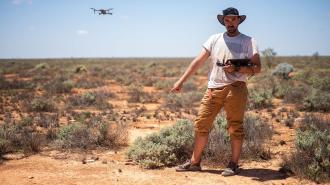An AI algorithm was able to locate a meteorite in drone footage for the first time, allowing scientists to rapidly retrieve it. This technology could help us greatly expand the number of space rocks recovered on Earth.
Space rocks 101: Meteoroids are bits of natural debris in space that are smaller than a meter in diameter, but larger than space dust.
Most broke off from asteroids or comets, but some are bits of the moon or even other planets that were blasted into space following a collision.
When meteoroids fall into Earth’s atmosphere, they burn and appear as meteors (“shooting stars”) in the night sky. Every year, about 17,000 of them survive the trip and land on the planet’s surface — those are “meteorites.”
Most meteorites are about the size of a speck of dust, and larger ones can look an awful lot like Earth rocks.
The challenge: By recovering these fallen space rocks, we can learn about how our solar system was formed without the costly, complicated process of going to space to retrieve samples.
The problem is that most meteorites are about the size of a speck of dust by the time they make it through the atmosphere to land on Earth. Even the larger meteorites look an awful lot like the Earth rocks strewn about the surface.
Eyes on the sky: Researchers in Australia created the Desert Fireball Network, a collection of 50 observatories that look for meteorites over one-third of the nation’s sky every night, all night long.
Astronomers only retrieved meteorites about 20% of the time when they hunted for them on foot.
Because the observatories are looking from different angles, data from multiple sites can be used to predict the trajectories of incoming space rocks, narrowing down their likely landing spot to an area that’s usually a little larger than one square mile.
A team of astronomers can then go to the predicted landing zone to hunt for the meteorite on foot. But this takes days, and about 80% of the time, it fails to recover the meteorite.
The idea: For their study, released on the preprint server arXiv, a team from Curtin University trained an algorithm to recognize meteorites in drone footage.
They then went to the predicted landing spot of a meteorite spotted falling to Earth in April 2021. Because only two cameras in the Desert Fireball Network had caught this shooting star, the potential landing area was larger than usual — about two square miles.
“There were about 10 seconds where I didn’t believe it … followed promptly by about two minutes of screaming.”
Seamus Anderson
For three days, they had two autonomous drones survey the area in a grid pattern. The data was then fed to their algorithm, which flagged four objects as potential meteorites. On the fourth day, the team walked to the objects — and one was a meteorite about the size of a computer mouse.
“There were about 10 seconds where I didn’t believe it and needed to take a hard look to confirm, followed promptly by about two minutes of screaming,” lead researcher Seamus Anderson told Physics World.
The to-do list: This is the first time anyone has used a drone with AI to recover a meteorite, but the system still needs some work — the AI may have been trained to find meteorites, but the researchers told Discover Magazine it tends to flag any anomaly on a landscape, from tin cans to kangaroos.
Training the AI to recognize other weird objects may help cut down on the false positives.
Drones would also struggle to help astronomers recover meteorites in places with heavy tree cover, thick grasses, or other natural features that make it difficult to spot small objects from the sky.
“To be able to increasingly automate the process of retrieving meteorites will bring the costs of searching down.”
Martin Suttle
The big picture: Even if drones and AI can’t capture every fallen space rock, the more meteorites astronomers have to study, the better their chances of gleaning new insights into space and the history of our solar system.
“Researchers rely on the recovery of new meteorites,” Martin Suttle, a meteorite expert at the Open University, who wasn’t involved in the study, told Physics World. “To be able to increasingly automate this process, reducing the number of researchers needed in big fieldwork expeditions, will bring the costs of searching down.”
We’d love to hear from you! If you have a comment about this article or if you have a tip for a future Freethink story, please email us at [email protected].




